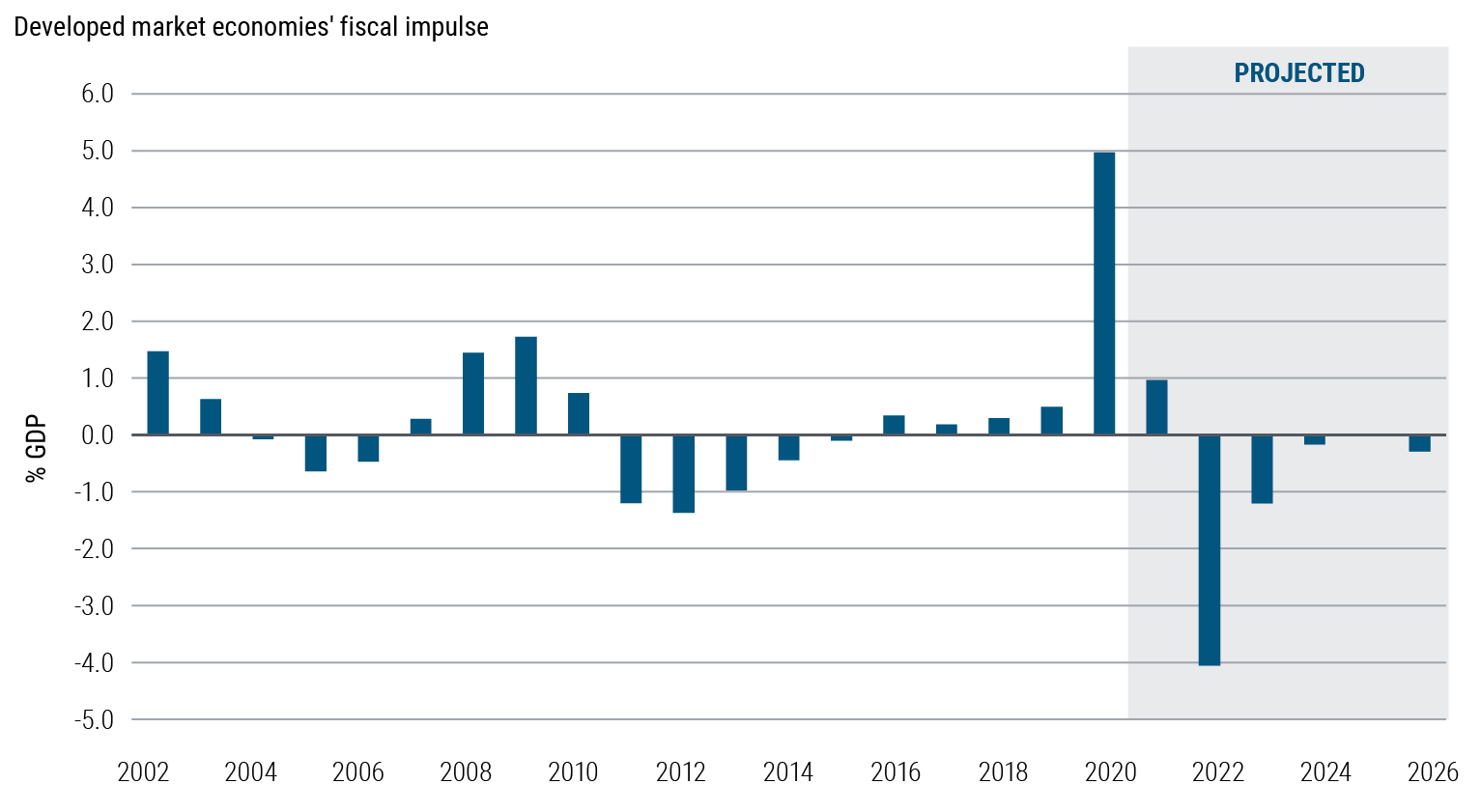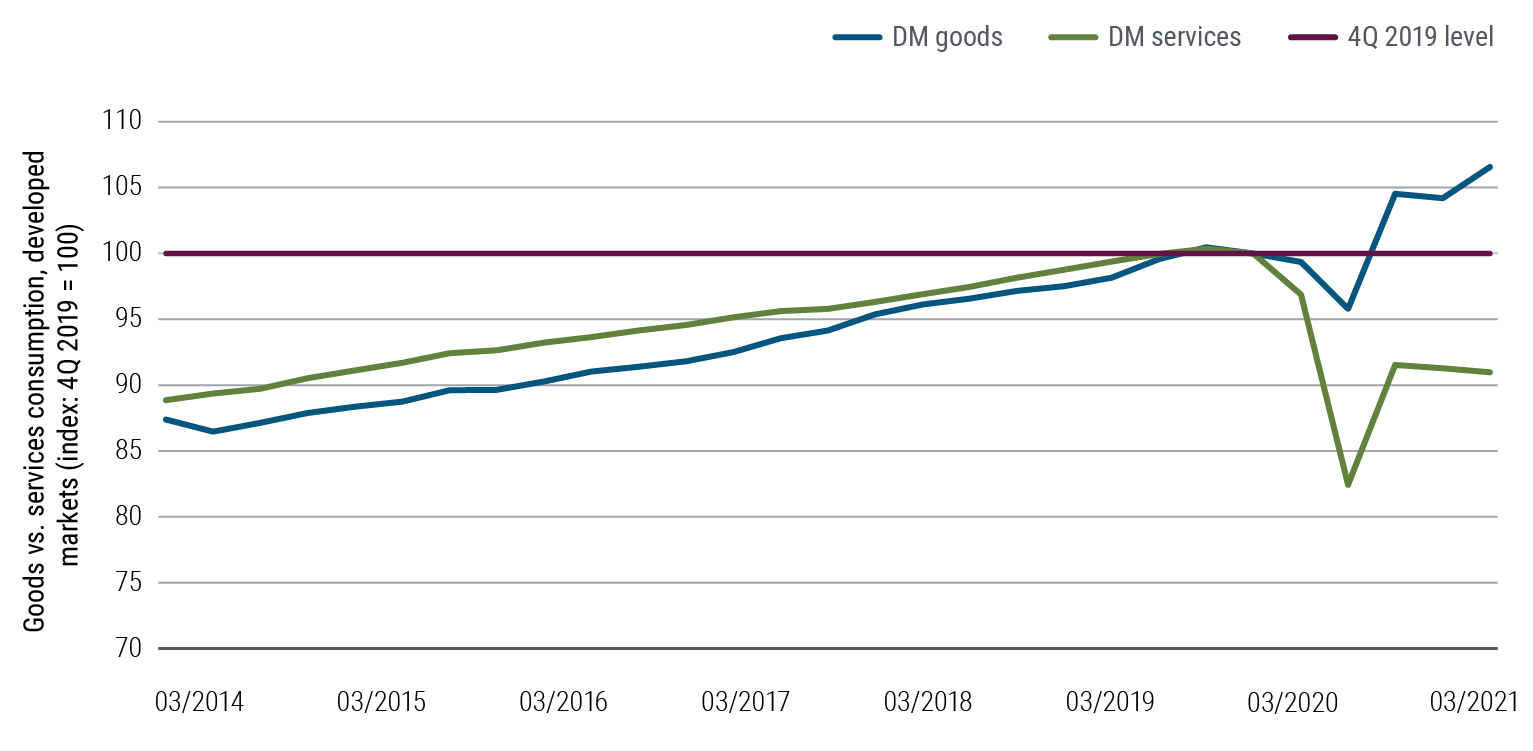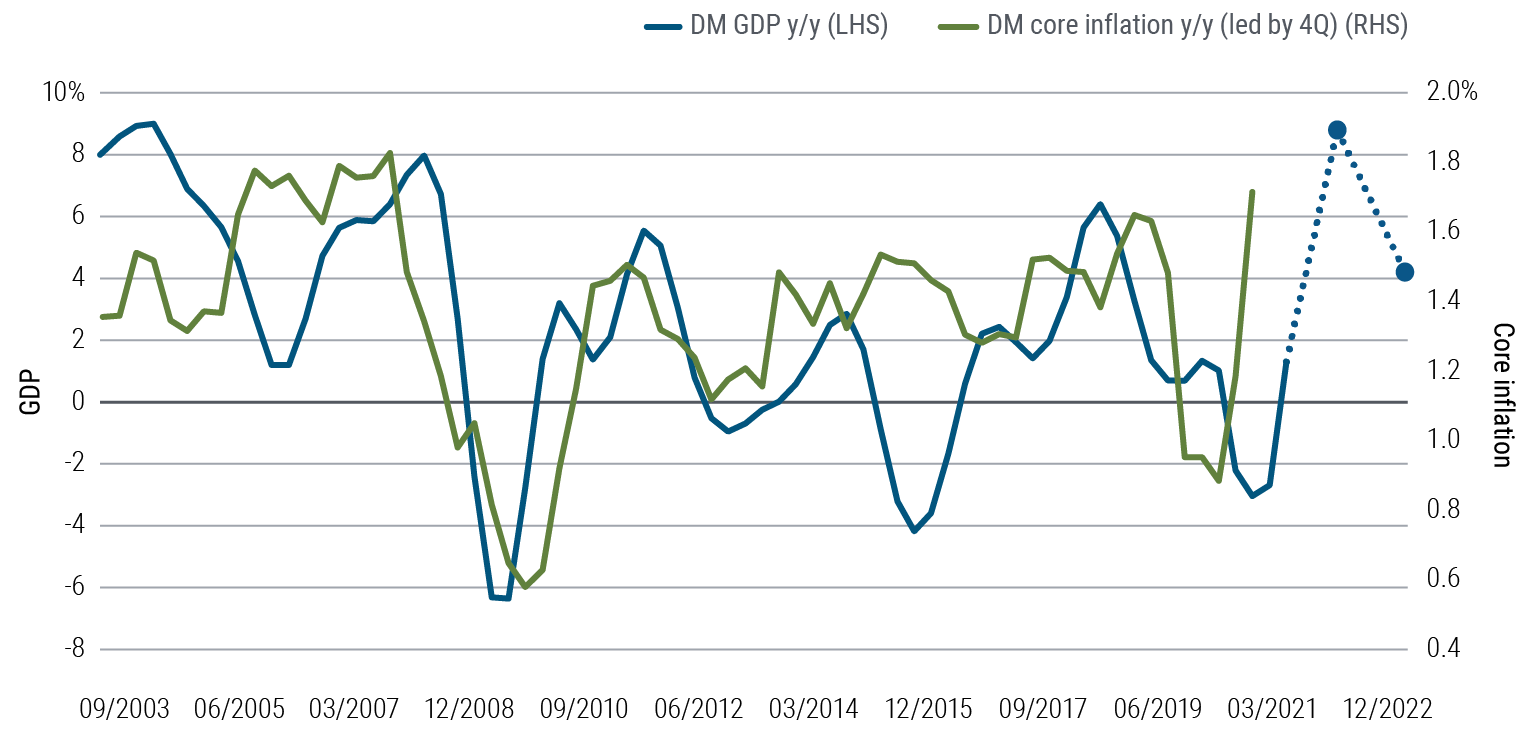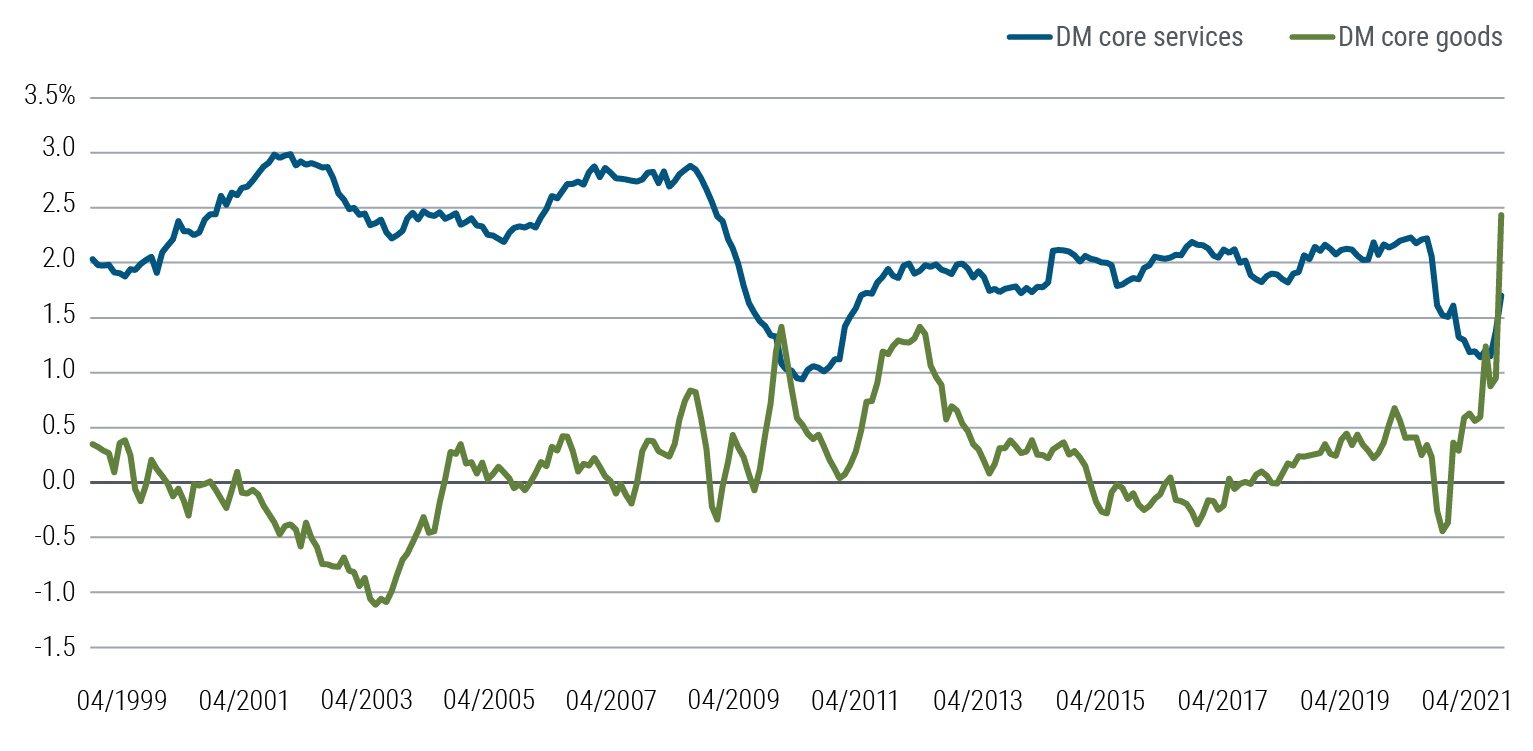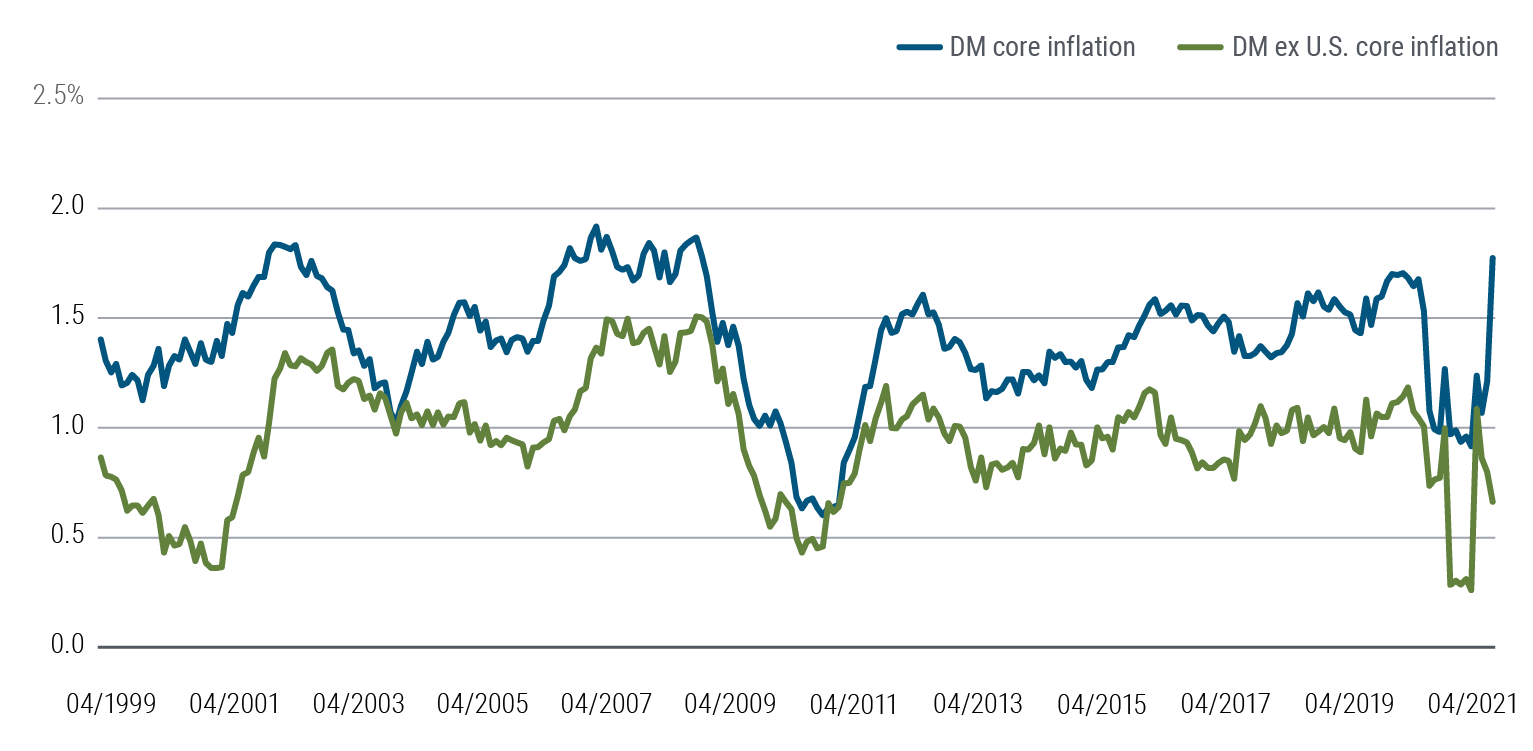Inflation Inflection
- In 2021, we expect the global growth recovery will be uneven across sectors and regions. In 2022, the rebound will likely give way to a synchronized growth moderation, albeit to a still above-trend pace.
- Though some central banks have begun tapering asset purchase programs already in 2021, with others likely to follow, we do not expect any developed market central banks to begin hiking policy rates over our cyclical horizon.
- We forecast inflation in developed markets will peak in the coming months. However, the exact timing and magnitude is uncertain, largely due to supply constraints.
- In markets, we are seeing fewer high conviction opportunities, and we believe valuations are generally rich. We think it makes sense to be patient and focus on maintaining liquidity and flexibility in our portfolios to respond to events and opportunities.
- On duration, we expect to maintain a modest underweight position in our model portfolios. In spread positions, we continue to favor non-agency U.S. mortgages and other asset-backed securities. Within corporate credit, we see little potential for significant spread tightening.
- We expect to find good opportunities in emerging market (EM) local and external bonds, as well as select EM currencies. But we will take a cautious approach at a time of ongoing COVID-related challenges in EM countries.
Economic Outlook
Over the past few months, economic recoveries have been uneven across regions and sectors. In the case of the U.S., this has contributed to supply chain bottlenecks and a bump up in inflation. Nonetheless, at PIMCO we continue to view the factors driving the recent price surge as transitory and, as a result, haven’t materially changed our broader views on the impact of the pandemic, policy, or economic growth since our March Cyclical Outlook.
So far, the market reaction to these macro developments has been generally muted, and despite higher inflation risks, the yield on the 10-year U.S. Treasury note has declined 25 basis points since mid-March. However, as we discussed at our Cyclical Forum in March, we see risks that greater macro uncertainty and volatility translate into a similar increase in volatility across asset markets. As a result, we believe it makes sense to be patient at a time of more limited high conviction opportunities and generally rich valuations, and to focus on maintaining liquidity and flexibility in our portfolios. If markets overshoot, as they tend to do, we want to have the flexibility to take advantage of these opportunities.
Economic outlook: peak pandemic, peak policy, peak growth
Over the last several months, public health data have indicated that the global pandemic, measured by number of cases, likely has peaked in the second quarter of 2021. The seven-day rate of new cases of COVID-19 globally declined from around 5.8 million per week in mid-April to 2.9 million in early June. At the same time, despite a bumpy start, vaccination rates across developed markets (DM) have accelerated, and DM countries are now projected to reach herd immunity over the next several months. As a result, global rates of new cases and deaths are likely to continue to decline, despite slower vaccination rates in emerging markets (EM) countries.
However, with the pandemic receding, policy support has also likely peaked. Within DM, the fiscal impulse, or the change in structural government deficits, is now waning, and will turn into an outright drag on growth in the months ahead (see Figure 1). We believe this will occur despite any new U.S. infrastructure spending. The additional pandemic relief legislation passed in March 2021 boosted the U.S. economy, with positive spillovers to the rest of the world. However, the U.S. household stimulus checks, which largely drove the DM fiscal impulse in 1Q 2021, won’t repeat, and the federal government’s enhanced unemployment benefits are expected to fully expire by the end of 3Q.
Similarly, tighter financial conditions in China have slowed credit growth in one of the world’s major economic engines, while developed market central banks have started to slowly shift direction, either by taking the first step toward policy normalization (e.g., the Bank of Canada and Bank of England tapering asset purchases) or signaling plans to do so (e.g., the U.S. Federal Reserve (Fed) indicating it discussed tapering at the June meeting).
These factors will tend to impact growth to varying degrees across industries and across regions, and will likely result in a somewhat desynchronized DM growth rebound in 2021. However, we expect the rebound will give way to a synchronized growth moderation in 2022, albeit to a still strong, above-trend pace. In particular, after the recession and partial retracement in economic output in 2020, we believe the U.S., U.K., Canada, and China likely achieved peak growth for 2021 in the second quarter, while the EU and Japan will likely peak in the third and fourth quarters, respectively.
On a sector basis, peak demand growth for consumer goods will also likely give way to a reacceleration in services spending. While many aspects of the COVID-related recession have been unique, the absence of a contraction in consumer goods demand has been particularly notable. Across DM countries, consumers generally substituted durable goods purchases for services (see Figure 2). For example, U.S. sales of exercise bikes exploded while spending on fitness center memberships plummeted. Similarly, demand for autos accelerated as public transportation declined. There are many more examples. However, while the above-trend pace of goods consumption was an important contributor to the overall recovery in DM in the second half 2020 and the first half of 2021, this growth will also likely peak in the second or third quarter of this year, as the pandemic fades (it is hoped) and consumer preferences shift back toward services spending.
Overall, we expect DM real GDP will grow 6% in 2021 (measured by 4Q over 4Q) and moderate to below 3% in 2022. Meanwhile, slower vaccination rates especially in the EM countries will likely delay a fuller recovery relative to DM. We expect EM GDP growth to accelerate up to 5% in 2022 (4Q/4Q), after growing 3.5% in 2021.
Inflation: a spike but not a spiral
Since DM inflation generally lags DM growth, we also project inflation to peak in the coming months (see Figure 3). However, the exact timing and magnitude is more uncertain due to supply constraints, which have had a larger-than-anticipated impact on realized goods inflation. As of April 2021, core DM inflation at 1.7% (year-over-year or y/y) had fully recovered from its pandemic dip; however, the composition of the inflationary pressures was quite different. Indeed, while services inflation was still well below its pre-pandemic level, goods inflation was well above (see Figure 4).
Looking closely at the data, the acceleration in goods inflation in developed markets was largely driven by the skyrocketing prices of U.S. used autos. The global shortage of semiconductors has hindered U.S. production of new cars more so than in other developed markets. The price effects of the shortages are evident chiefly in the used car market, in large part due to U.S. rental car companies resorting to used cars to rebuild fleets after liquidations last year. Logistical bottlenecks have also plagued the U.S. goods market: West Coast port congestion and a dearth of truck drivers have lengthened delivery times and increased costs, which are being passed on to consumers.
Nonetheless, these supply constraints are expected to ease in 2022, and this coupled with peaking goods demand will likely moderate inflation in the second half of 2021. Furthermore, with the unemployment rate at 5.8%, the U.S. is still quite a ways from full employment. The labor situation along with a relatively flat Phillips curve (suggesting the statistical relationship between employment and inflation is less significant), still-anchored inflation expectations, and accelerating productivity growth make the risk of spiraling U.S. inflation seem remote.
Outside of the U.S., underlying inflationary pressures in other developed markets have been much more subdued. Indeed, as of April 2021, DM core inflation excluding the U.S. was running around 0.6% y/y versus 3.0% core U.S. inflation (see Figure 5). This divergence has occurred despite the global nature of the supply chain bottlenecks, because fiscally stimulated demand for goods in the U.S. has also outpaced other developed markets. However, the fact that the large fiscal transfers aren’t likely to repeat and U.S. fiscal policy will turn to a drag on growth in 2022 argues for inflation to also moderate in 2022.
Overall, we forecast DM inflation to end 2021 running at a 3% average annual pace, before moderating back to 1.5% in 2022 – below DM central bank targets. For the U.S., we expect the y/y rate of core inflation to peak in 2Q 2021 around 4%, and end the year at 3.5%, before moderating back to 2.3% in 2022.
Policy handoff doesn’t come without risks
Our base case for growth and inflation has both downside and upside risks. The handoff from policy-induced growth to organic growth could be better than expected … or it could be worse. Upside risks include 1) a large accumulation of excess household savings that fuels a more pronounced consumption boom (while likely contributing to higher inflation), 2) an elevated pace of innovations and higher productivity growth that supports corporate profits and real wages, or 3) generally easy financial conditions that continue to support lending and capital formation.
On the other hand, downside risks to the baseline outlook include 1) higher inflation that squeezes corporate margins and erodes real household incomes, 2) economic reallocation that takes a long time and results in elevated levels of long-term unemployment, or 3) more permanent changes in post-pandemic household preferences toward savings and consumption.
Central banks stay the course
Since March 2021, many major DM central banks started to gradually shift the stance of monetary policy. The Bank of Canada (BOC) and Bank of England (BOE) took the first steps toward policy normalization by tapering their bond purchases, while the Federal Reserve indicated that at the June meeting it started discussing plans to wind down its purchase programs.
Turning to the outlook, we continue to expect the Fed to initiate a gradual tapering of its monthly asset purchase pace later in 2021, and to end the purchases by 3Q 2022. Regarding the announcement timing, we continue to view the December Fed meeting as most likely; however, we wouldn’t rule out an announcement as early as September. Although the current U.S. inflation spike is likely to be transitory, the Fed may want to manage the risk of an unwanted acceleration in inflation expectations by bringing forward its tapering plans modestly. This would also give the Fed the option to further adjust its outlook for policy rate hikes in the event higher U.S. inflation does prove to be more persistent.
Conversely, we think it’s likely that the ECB continues purchasing assets (also known as quantitative easing or QE) through our cyclical horizon. While it is possible that small adjustments are made to the ECB purchase programs, we see a low likelihood that the ECB will meet its inflation objective by 2022. Therefore, implementing a clear path and strategy for ending purchases is likely a question for the ECB over our secular (not cyclical) horizon.
Finally, notwithstanding the expected changes to DM central banks’ QE programs, we don’t expect DM central banks to begin hiking policy rates over our cyclical horizon. Indeed, the central banks in Canada, New Zealand, and Australia are likely to lead with the first hikes in 1H 2023, followed by the Fed and BOE in 2H 2023, in our view. The ECB, which has had more difficulty in meeting its 2% inflation target over the last decade, isn’t expected to hike until much later, while the Bank of Japan continues to struggle with deflationary trends.
Investment implications
Our macro and market outlook is very similar to our March conclusions, so we have not made significant changes to our model portfolios. Since we are seeing fewer high conviction opportunities and we believe valuations are generally rich, we think it makes sense to be patient and focus on maintaining liquidity and flexibility in our portfolios to respond to events and opportunities.
There is still a high level of uncertainty in the outlook, including the upside and downside risks to growth and inflation, and the start of QE tapering outside the U.S. and the likely Fed taper later this year.
Of course, there is always uncertainty in any outlook, but at the moment it is very hard to read the incoming data given the unprecedented COVID-related disruption and recovery. Moreover, any Fed taper talk – however carefully communicated – could lead to market disruption, especially in spread sectors given that we have already had significant volatility in global rates markets. That said, market responses to BOC and BOE taper announcements earlier this year were undramatic, and in the U.S., conditions are very different today compared with 2013. Back then, the Fed taper announcement was a surprise; today we have been discussing the timing of the end of QE for months, and the Fed has also laid out a very slow path for actual rate hikes. But at minimum, tapering adds to the uncertainty in the outlook. And reduced QE, in the U.S. and globally, is not going to make risk transfer easier in the affected markets.
Duration and yield curve
On duration, we expect to stay close to home while maintaining a modest underweight position versus our benchmarks. Looking back over the past 18 months, we think in terms of U.S. and global duration, we have completed the round trip from very low yields amid the pandemic shock to the subsequent rise in yields – and associated volatility – as markets priced in vaccine efficacy and the recovery. As of mid-June we are just below the rough 1.5%–2.0% range we forecast for the 10-year U.S. Treasury note over the coming months, and we expect to be modestly underweight duration while being careful on correlation with other positions in our portfolios.
We also expect to have a curve steepening position, in line with our long-held structural bias and also as a source of income. We continue to expect that central banks will anchor the front end, while given heightened inflation concerns, there is the potential for higher longer-dated yields. In our view, with the Fed on a very slow path to tightening, curve is a very liquid way to position portfolios in an effort to benefit from heightened inflation concerns, and we believe a globally diversified steepening position in sovereign bonds across Europe, the U.K., and Japan makes sense. As with the comments on duration above, we will be careful about the correlation between curve positions and other risk positions in our portfolios.
Credit
We expect to be overweight overall in spread portfolios, with current allocations to non-agency U.S. mortgages and other asset-backed securities a key component of the spread positioning. We continue to believe that non-agency mortgages offer good value versus generic cash corporates, along with favorable risk profiles. Limited supply is also supportive.
On corporate credit, we see little potential for significant spread tightening, given valuations adjusted for issuers’ leverage. But there is also likely to be strong ongoing demand for credit, even at compressed spreads, given low government yields. And a decline in hedging costs for foreign investors could continue to provide support for U.S. credit.
We expect credit derivative indices will be the primary way of obtaining credit beta, and in generalist portfolios we will look to limit cash corporate positions to the highest-conviction single name ideas identified by our global team of credit analysts. Single name selection will also likely continue to be an important alpha driver in specialist credit mandates, with a likely focus on financials, cyclicals, housing-related sectors, and COVID-19 recovery trades.
We are targeting a neutral to underweight position in agency mortgage-backed securities (MBS), given expensive valuations, lack of carry or income generation, and an impending Fed taper, which may make intermediation more difficult in MBS.
Inflation-linked bonds
A Fed taper would also affect markets for U.S. Treasury Inflation-Protected Securities (TIPS). Given current valuations and liquidity considerations, we expect to be fairly neutral on TIPS, although in some portfolios a TIPS overweight may continue to make sense given the still reasonably priced hedge against upside inflation surprises.
Currencies and emerging markets
We continue to favor U.S. dollar underweights – with careful scaling – versus G-10 commodity-related currencies and select EM currencies. This reflects a combination of the forecast for ongoing global expansion (with the currencies of small, open economies poised to benefit from the ongoing cyclical upswing), valuations, and the Fed’s very patient approach compared with its history and the potential for somewhat faster policy tightening elsewhere.
In addition to currencies, we expect to find good opportunities in emerging market local and external bonds. But we will take a cautious approach at a time of ongoing COVID-related challenges in EM countries.
Equities
In our view, equity valuations are now fair with the U.S. equity risk premium at 3.5%, which is in line with the mid-cycle expansion average. With earnings continuing to be revised higher, we remain overweight equities in our asset allocation portfolios. Given valuations, the focus is now on sector and security selection of companies likely to benefit from the further reopening of the service sector, as well as cyclicals that are in secularly supported sectors with pricing power and barriers to entry, like semiconductors, technological automation, and green industries.
Commodities
Commodities have had a meaningful move higher on the back of strong global demand. Looking forward, we believe spot price gains will be lower as producer hedging increasingly caps longer-dated prices. The positive roll yield, in aggregate near the highest it has been in the past 20 years, will be important for driving future returns. (Roll yield refers to returns generated as a longer-term futures contract over time “rolls” into a shorter-term contract as it nears expiration.)
As we discussed at recent forums, many public and private leaders are intently focused on climate and social equity calls to action, which may add a new dimension to policymaking, regulatory disclosures, capital formation, sustainable investment, and potential market adjustments on the cyclical horizon. We see sustainability trends accelerating, as Mark Carney reminds us, heading into COP26 this November 2021, as global policymakers and business leaders look to make tangible, lasting progress on climate targets. Notable growth in ESG-labeled bond issuance this year reflects adoption in sustainability-related objectives for issuers ranging from sovereigns to corporates, seeking to keep up with supportive demand from capital allocators.
Download PIMCO's Cyclical Outlook
Download PDFAbout our forums
Honed over more than 50 years and tested in virtually every market environment, PIMCO’s investment process is anchored by our Secular and Cyclical Economic Forums. Four times a year, our investment professionals from around the world gather to discuss and debate the state of the global markets and economy and identify the trends that we believe will have important investment implications.
At the Secular Forum, held annually, we focus on the outlook for the next five years, allowing us to position portfolios to benefit from structural changes and trends in the global economy. Because we believe diverse ideas produce better investment results, we invite distinguished guest speakers – Nobel laureate economists, policymakers, investors, and historians – who bring valuable, multidimensional perspectives to our discussions. We also welcome the active participation of the PIMCO Global Advisory Board, a team of world-renowned experts on economic and political issues.
At the Cyclical Forum, held three times a year, we focus on the outlook for the next six to 12 months, analyzing business cycle dynamics across major developed and emerging market economies with an eye toward identifying potential changes in monetary and fiscal policies, market risk premiums, and relative valuations that drive portfolio positioning.
Featured Participants
Disclosures
Past performance is not a guarantee or a reliable indicator of future results.
All investments contain risk and may lose value. Investing in the bond market is subject to risks, including market, interest rate, issuer, credit, inflation risk, and liquidity risk. The value of most bonds and bond strategies are impacted by changes in interest rates. Bonds and bond strategies with longer durations tend to be more sensitive and volatile than those with shorter durations; bond prices generally fall as interest rates rise, and low interest rate environments increase this risk. Reductions in bond counterparty capacity may contribute to decreased market liquidity and increased price volatility. Bond investments may be worth more or less than the original cost when redeemed. Mortgage- and asset-backed securities may be sensitive to changes in interest rates, subject to early repayment risk, and while generally supported by a government, government-agency or private guarantor, there is no assurance that the guarantor will meet its obligations. Corporate debt securities are subject to the risk of the issuer’s inability to meet principal and interest payments on the obligation and may also be subject to price volatility due to factors such as interest rate sensitivity, market perception of the creditworthiness of the issuer and general market liquidity. Inflation-linked bonds (ILBs) issued by a government are fixed income securities whose principal value is periodically adjusted according to the rate of inflation; ILBs decline in value when real interest rates rise. Treasury Inflation-Protected Securities (TIPS) are ILBs issued by the U.S. government. Investing in foreign-denominated and/or -domiciled securities may involve heightened risk due to currency fluctuations, and economic and political risks, which may be enhanced in emerging markets. Currency rates may fluctuate significantly over short periods of time and may reduce the returns of a portfolio. Equities may decline in value due to both real and perceived general market, economic and industry conditions. Commodities contain heightened risk including market, political, regulatory, and natural conditions, and may not be appropriate for all investors.
Statements concerning financial market trends or portfolio strategies are based on current market conditions, which will fluctuate. There is no guarantee that these investment strategies will work under all market conditions or are appropriate for all investors and each investor should evaluate their ability to invest for the long term, especially during periods of downturn in the market. Investors should consult their investment professional prior to making an investment decision. Outlook and strategies are subject to change without notice.
Forecasts, estimates and certain information contained herein are based upon proprietary research and should not be considered as investment advice or a recommendation of any particular security, strategy or investment product. There is no guarantee that results will be achieved.
Alpha is a measure of performance on a risk-adjusted basis calculated by comparing the volatility (price risk) of a portfolio vs. its risk-adjusted performance to a benchmark index; the excess return relative to the benchmark is alpha.
PIMCO as a general matter provides services to qualified institutions, financial intermediaries and institutional investors. Individual investors should contact their own financial professional to determine the most appropriate investment options for their financial situation. This material contains the opinions of the manager and such opinions are subject to change without notice. This material has been distributed for informational purposes only and should not be considered as investment advice or a recommendation of any particular security, strategy or investment product. Information contained herein has been obtained from sources believed to be reliable, but not guaranteed. No part of this material may be reproduced in any form, or referred to in any other publication, without express written permission. PIMCO is a trademark of Allianz Asset Management of America LLC in the United States and throughout the world. ©2023, PIMCO.

